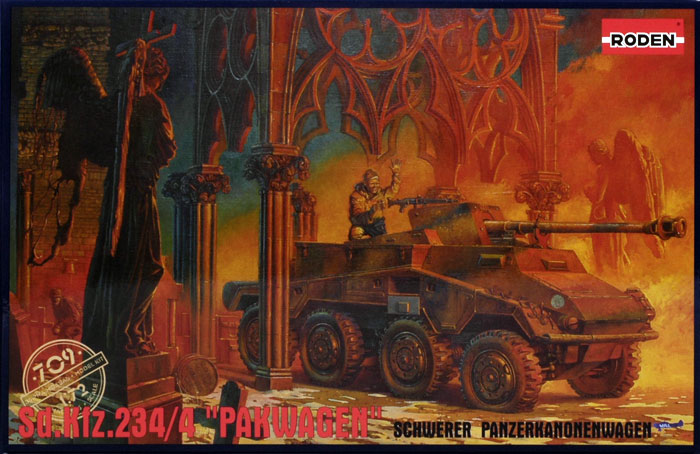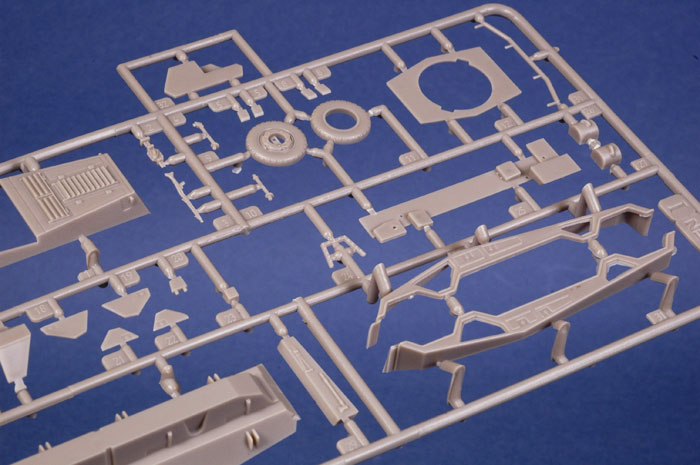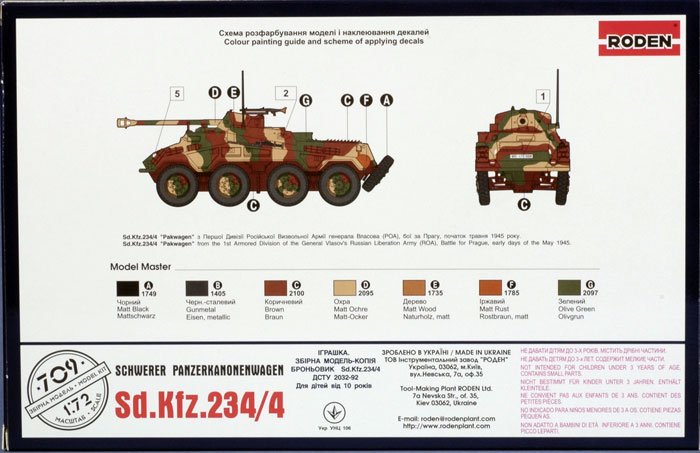|
|
|
|
| Home > Reviews > Small Scale > Roden 1/72 Sd.Kfz 234/4 (709) |
Sd.Kfz 234/4 "Pakwagen"
Roden 1/72 Scale
Reviewed by Glen Porter

Summary
| Stock Number and Description | Roden No 709 Sd.Kfz. 234/4 |
| Scale: | 1/72 |
| Media and Contents: | 104 black plastic parts on two identical sprues, 64 tan coloured plastic parts on three sprues, decals for two vehicles plus an eight page A5 sized instruction sheet with history, parts plan, twelve build diagrams and one page of paint/decal instructions. |
| Price: | |
| Review Type: | First Look |
| Advantages: | Long overdue subject; good exterior detail; excellent Pak 40; some interior detail. |
| Disadvantages: | Some dimensional issues. |
| Recommendation: | Recommended |
A Brief History
The Sd.Kfz. 234/4 Pakwagen was the last of the eight wheeled Armoured Cars built before the war in Europe came to an end. It was essentially a Puma with the turret removed and a Pak 40 Anti Tank Gun fitted in its place. Only about 89 of this model were produced.
FirstLook
This, the
last of the eight-wheeled armoured cars from Roden, has been a long
time coming but there is a reason for it. They've been waiting for
their Pak 40 Anti Tank Gun (Kit No 711) to be ready as one of the
two sprues from that kit is an integral part of this one.
I am told that all of these armoured car kits from Roden have some
shape problems but quite frankly I'm willing to overlook these as
they have given us a range of vehicles that we have never seen
before in Braille. I'm not enough of an expert to tell if they're
not totally accurate in every dimension, but I do know that the
detail level is high with even some interior fittings supplied. They
are also quite buildable and, when completed, really look the part.
As well as the Pak 40 sprue, there is one for this kit alone along
with the other three which are in all of the Sd.Kfz.234 based kits.
On entering the end-opening box with the attractive and inspiring
art-work, you will find five plastic sprues sealed in a clear
plastic bag.

Click the thumbnails below to view larger images:
Two of
these sprues are identical and in black plastic and are two of the
three generic 234 sprues. I don't know why Roden persist in this
black plastic. It doesn't seem to serve any purpose. It just makes
it harder to see any detail in the plastic such as defects that need
to be attended to before painting. These carry the wheels,
suspension and many of the small interior and exterior detail parts
like jerry cans, tools, seats and steering columns. There are no
sink marks or other imperfections on these sprues. The third generic
sprue, in tan plastic, is the basic upper and lower hull, guards
(fenders) and other small external items. The three sprues mentioned
so far are the two identical A sprues (Black) and the I sprue
(Tan).
F is for this kit alone in tan plastic and carries the gun mounts
and armoured shields that surround the fighting compartment.
H is from the Pak 40 kit, also in tan, and has all the parts for
gun and shield. There are some sink marks on either side of the gun
breech which should not be a problem to fix and I could not find any
others. Some ejector pin marks are visible on a few areas but again
will not be noticeable once the model is constructed. A small amount
of flash is noticeable but like the sink and ejector pin marks will
not cause any head aches. The close defence machine gun in my kit
was bent but not broken. The four larger equipment boxes in the
guards can be modelled open but the guards themselves will require
thinning above the wheels. Detail on all sprues is up to the
standard we've come to expect from this manufacturer.
There are only two colour schemes, both identical late war three
colour jobs, one from General Vlasov's Russian Liberation Army,
Battle for Prague, May 1945 and one from the Battle for Berlin, last
days of April-early days of May 1945.

The small decal sheet has separate black and white crosses and number plates for only one of the vehicles.
Conclusion
As I
mentioned above, I do not consider myself expert enough to pick any
inaccuracies but at least we now have a complete range of 8 Rads and
if they've inspired some other model manufacturers to do even better
well, thank you Roden.
Recommended to all Braille Armour Nuts.
Thanks to JB Wholesalers for the review sample.
Text by Glen Porter
Page Created 08 September, 2007
Page Last Updated
07 September, 2007





